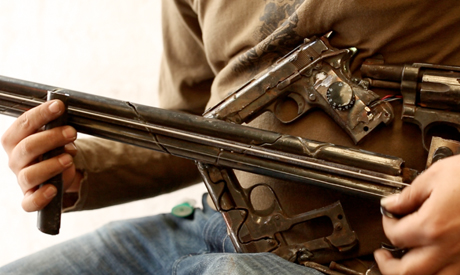
(Photo: Pedro Reyes blog site)
"Imperfection," the title of Istanbul's inaugural Design Biennial, pays tribute both to the dynamism of its host city as well as to the design world's shift away from mass production.
Part art show, part expo, the biennial showcases almost 100 examples from architecture, city planning, interior and industrial design, fashion and new media in two separate exhibition spaces curated by Milan-based architect and writer Joseph Grima and local architect Emre Arolat.
"Design today is evolutionary. It's about creating systems that can be interpreted, adapted, sampled and copied ... rather than a perfectly produced object from the factory," said Grima, who curated the exhibit Adhocracy.
"Designers who can harness that spirit and transform it into objects are the protagonists of the future."
Adhocracy is set in a grand but crumbling school that once educated Istanbul's dwindling ethnic Greek population before it ran out of primary school students. The whir of 3-D printers is at odds with the neo-classical surrounding.
More than 200 designers and architects from 46 countries contributed to the Design Biennial.
The theme of collaboration is apparent in Belgium-based designer Thomas Lommee's OpenStructures, which asks designers to create objects from the same modular unit. On display are a sled, a suitcase, a bike.
"This is like a Meccano toy using the Wikipedia model to create a dynamic puzzle," Lommee said. "When your kid grows up and the sled is no longer useful, you make something else that is. It is the idea that objects are able to evolve and grow."
Among the most powerful works is Imagine by Mexican artist Pedro Reyes. He transformed 6,700 weapons seized in Mexico's drug war into musical instruments, and the functioning orchestra includes a violin, flute and drums.
'CALAMITY'
Less than a kilometre away at the Istanbul Museum of Modern Art, Arolat's Musibet, which translates as "calamity," focuses mostly on Istanbul and its evolving skyline.
Here the title Imperfection, coined by Deyan Sudjic, director of London's Design Museum and an adviser to the Istanbul biennial, evokes the urban jumble of Istanbul, a city of some 15 million people notorious for chronic traffic jams, ancient monuments and haphazard modern buildings.
Musibet's darkened, narrow spaces recreate the sense of unease that the constant state of flux in Europe's biggest city has aroused in some of its denizens.
Recent years have seen developers raze historic Istanbul neighbourhoods to build modern housing projects, backed by Prime Minister Tayyip Erdogan's popular, conservative government that has presided over economic growth averaging 5 percent since it took office in 2002.
"Many have qualms about how the process of urban renewal has been decided behind closed doors at the top," said Arolat.
"It is part of Turkey's historic rupture in the relationship between the government and the governed, and naturally this is also reflected in design culture, especially urban design."
The intersection of politics, design and religion is neatly captured in Aydan Celik's Vertical Fantasies of Neo-Conservatism.
The illustration is a satirical take on mahya, the Turkish tradition of suspending lights that spell out devotional messages from the minarets of imperial mosques during the Islamic holy month of Ramadan. Celik's succinct message is Insaat a Resulullah (or Construction, Messenger of Allah).
Almost 40,000 people have visited the biennial since its opening on 13 Octoberorganisers said. It runs through 12 December.
Short link: